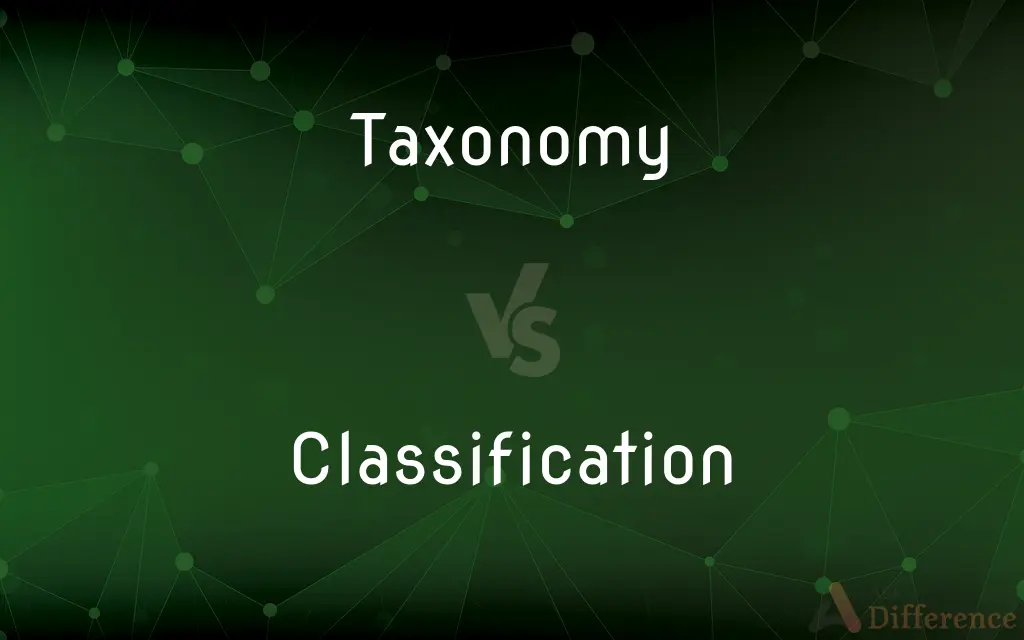Taxonomy vs. Classification — What's the Difference?
By Tayyaba Rehman & Urooj Arif — Updated on March 20, 2024
Taxonomy involves organizing living organisms into hierarchical categories, while classification refers to the process of grouping entities based on shared characteristics.

Difference Between Taxonomy and Classification
Table of Contents
ADVERTISEMENT
Key Differences
Taxonomy is a branch of biology concerned with the classification, naming, and identification of organisms into a structured system. It involves creating a hierarchical framework that encompasses kingdoms, phyla, classes, orders, families, genera, and species. Classification, on the other hand, is a broader concept that applies not only to biology but to various fields. It involves organizing items, concepts, or entities into categories based on shared traits or characteristics.
In taxonomy, the focus is on understanding evolutionary relationships and the natural order among organisms. This scientific discipline uses a set of rules for naming and categorizing organisms to reflect their genetic and evolutionary relationships. Classification, while integral to taxonomy, can be applied in many other contexts, such as grouping books in a library or categorizing different types of rocks in geology.
Taxonomic classification is a specific application of the broader principle of classification. It is a critical part of taxonomy, where organisms are grouped into a hierarchical structure based on their physical and genetic characteristics. In contrast, general classification might not adhere to a hierarchical structure and can be based on arbitrary or chosen characteristics depending on the context.
The principles and methodologies used in taxonomy, such as cladistics, phenetics, and evolutionary taxonomy, are specialized and tailored to understanding the complexities of biological diversity and evolution. Conversely, the methods used in general classification might be simpler and more varied, depending on the nature of the items or concepts being classified.
One of the key outcomes of taxonomic efforts is the development of a universally accepted naming system for organisms, known as binomial nomenclature, which provides a unique and standardized name for each species. In broader classification systems, the naming conventions can be more flexible and context-dependent, serving the specific needs of the field or discipline.
ADVERTISEMENT
Comparison Chart
Definition
The science of naming, identifying, and classifying organisms
The process of grouping entities based on characteristics
Scope
Primarily biological organisms
Various fields and entities
Structure
Hierarchical system (kingdom to species)
Can be hierarchical or non-hierarchical
Focus
Evolutionary relationships and natural order
Shared traits or characteristics
Methodologies
Cladistics, phenetics, evolutionary taxonomy
Varies by field, often less complex
Naming System
Binomial nomenclature for unique identification
Context-dependent, more flexible
Application
Understanding biological diversity and evolution
Organizing and categorizing items or concepts
Compare with Definitions
Taxonomy
The science of classifying and naming biological organisms in a hierarchical system.
Homo sapiens is the taxonomic classification for humans.
Classification
The process of grouping entities based on shared characteristics, applicable in various contexts.
In a library, books are classified by genres and topics.
Taxonomy
Organizes life forms from broad kingdoms to specific species.
The classification of a domestic dog starts at the kingdom Animalia and ends with the species Canis lupus familiaris.
Classification
Can be hierarchical or not, depending on the system and context.
The Dewey Decimal System classifies books into main classes and further subdivisions.
Taxonomy
Utilizes binomial nomenclature for consistent and universal naming.
The name for humans, Homo sapiens, adheres to binomial nomenclature rules.
Classification
Used across different disciplines, from biology to library science.
Rocks can be classified into igneous, sedimentary, and metamorphic categories.
Taxonomy
Taxonomy is specifically concerned with the organization of living organisms.
Taxonomic studies have led to the discovery and classification of new species.
Classification
Helps in organizing and categorizing a wide range of items or concepts.
Classification is used in data management to organize and categorize information.
Taxonomy
Reflects evolutionary relationships among organisms.
Birds and reptiles are grouped closely due to shared ancestral traits.
Classification
Classification systems can vary widely in naming conventions.
In educational systems, courses might be classified by departments and levels.
Taxonomy
The classification and naming of organisms in an ordered system that is intended to indicate natural relationships, especially evolutionary relationships.
Classification
The action or process of classifying something
The classification of disease according to symptoms
Taxonomy
The science, laws, or principles of classification.
Classification
The act, process, or result of classifying.
Taxonomy
An ordered arrangement of groups or categories
A taxonomy of literary genres.
Classification
A category or class.
Taxonomy
The science or the technique used to make a classification.
Classification
(Biology) The systematic grouping of organisms into categories on the basis of evolutionary or structural relationships between them; taxonomy.
Taxonomy
A classification; especially, a classification in a hierarchical system.
Classification
The act of forming into a class or classes; a distribution into groups, as classes, orders, families, etc., according to some common relations or attributes.
Taxonomy
The science of finding, describing, classifying and naming organisms.
Classification
The act of forming into a class or classes; a distribution into groups, as classes, orders, families, etc., according to some common relations or affinities.
Taxonomy
That division of the natural sciences which treats of the classification of animals and plants, primarily by consideration of their natural relationships with respect to their structure or genetic origin; the laws or principles of classification; systematics.
Classification
The act of distributing things into classes or categories of the same type
Taxonomy
A systematic arrangement of objects or concepts showing the relations between them, especially one including a hierarchical arrangement of types in which categories of objects are classified as subtypes of more abstract categories, starting from one or a small number of top categories, and descending to more specific types through an arbitrary number of levels. An ontology usually contains a taxonomy as one of the important principles of organization.
Classification
A group of people or things arranged by class or category
Taxonomy
A classification of organisms into groups based on similarities of structure or origin etc
Classification
The basic cognitive process of arranging into classes or categories
Taxonomy
(biology) study of the general principles of scientific classification
Classification
Restriction imposed by the government on documents or weapons that are available only to certain authorized people
Taxonomy
Practice of classifying plants and animals according to their presumed natural relationships
Common Curiosities
How does classification differ from taxonomy?
Classification is the broader process of grouping entities based on shared characteristics, whereas taxonomy is a specific branch of biology focused on classifying organisms.
Why is taxonomy important in biology?
Taxonomy helps scientists understand the diversity of life, evolutionary relationships, and provides a universal system for naming organisms.
What is taxonomy in biology?
Taxonomy is the science of classifying, naming, and identifying organisms within a hierarchical system, reflecting their evolutionary relationships.
What are some methods used in taxonomy?
Methods include cladistics, which focuses on common ancestry, phenetics, based on overall similarity, and evolutionary taxonomy, which considers both.
What is binomial nomenclature?
Binomial nomenclature is a system used in taxonomy to give each species a unique, two-part Latin name indicating its genus and species.
Can classification be used outside of biology?
Yes, classification is used in various fields to organize items or concepts, such as categorizing books in a library or types of rocks in geology.
Is the classification system always hierarchical?
In taxonomy, it is hierarchical, but in other contexts, classification systems can be hierarchical or non-hierarchical.
Can the same principles of taxonomy apply to classifying non-living things?
While the principles of taxonomy are specific to biological organisms, the general concept of classification can apply to non-living things, using different criteria.
How does taxonomy reflect evolutionary relationships?
Taxonomy groups organisms in a way that reflects their common ancestry and evolutionary paths, using characteristics derived from evolutionary biology.
How does classification help in everyday life?
Classification helps in organizing information, making sense of diverse items, and improving accessibility, such as categorizing products in stores or files in a computer.
Share Your Discovery

Previous Comparison
Raster vs. Vector
Next Comparison
Needle vs. PinAuthor Spotlight
Written by
Tayyaba RehmanTayyaba Rehman is a distinguished writer, currently serving as a primary contributor to askdifference.com. As a researcher in semantics and etymology, Tayyaba's passion for the complexity of languages and their distinctions has found a perfect home on the platform. Tayyaba delves into the intricacies of language, distinguishing between commonly confused words and phrases, thereby providing clarity for readers worldwide.
Co-written by
Urooj ArifUrooj is a skilled content writer at Ask Difference, known for her exceptional ability to simplify complex topics into engaging and informative content. With a passion for research and a flair for clear, concise writing, she consistently delivers articles that resonate with our diverse audience.














































